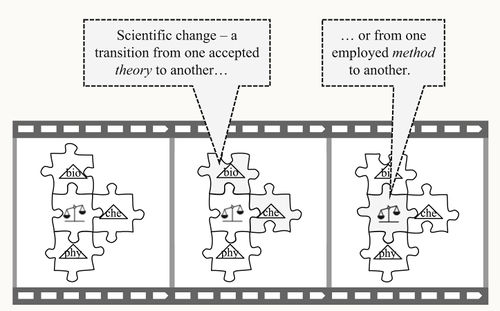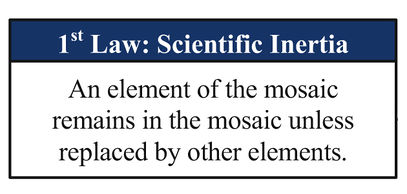The Theory of Scientific Change
Theory of Scientific Change (TSC) is a descriptive theory that attempts to explain changes in a scientific mosaic, i.e. transitions from one theory to the next and one method to the next. The current theory of scientific change explains many different aspects of the process such as theory acceptance and method employment, scientific inertia and compatibility, splitting and merging of scientific mosaics, scientific underdeterminism, changeability of scientific methods, role of sociocultural factors, and more.
Contents
Prehistory
Prehistory here
History
Current View
What is the theory of scientific change?
The theory of scientific change (TSC) is a general descriptive social scientific theory of the actual process of scientific change stated in axiomatic deductive form. It is the founding theory of the new field of scientonomy. It was proposed by Hakob Barseghyan in 2015 in his book 'The Laws of Scientific Change'.
Methods
As in the later works of Larry Laudan (Laudan, 1984), the TSC rejects the idea of a fixed universal scientific method, and accepts the idea that the methods of science have changed over time. This rejection is based on clear evidence from the history of science that the methods of science have, in fact, changed (Barseghyan, 2015, p. 3-21). In contrast to most earlier views of the process of scientific change, TSC draws a clear distinction between methods, which are the implicit standards actually used in theory assessment, and the normative epistemic methodologies espoused by scientists or philosophers of science. The TSC takes normative methodological prescriptions to be outside its scope. It seeks a purely descriptive account of the methods employed by scientists to assess theories (Barseghyan, 2015, p. 12-21). Following the resolution of logical problems by Sebastian (2016), it also views the descriptive study of scientific methodologies, and their relationship to employed methods, as within its scope. The TSC rejects Kuhn (1977)and Laudan's (1984) distinction between values and methods, asserting that values can more parsimoniously be included within the category of methods. Thus, the value of predictive accuracy is instead seen as the method 'accept theories that are predictively accurate'.
=Theory appraisal
The TSC draws a distinction between the process of scientific theory construction, in which new theories are generated or constructed, and that of theory appraisal, in which theories are evaluated. It seeks a descriptive account of the process of theory appraisal, but does not view the process of theory construction as a necessary part of its scope (Barseghyan, 2015, p. 21-30). The TSC seeks to clearly categorize the stances that a scientific community can take towards a theory. It posits three such stances: acceptance, use, and pursuit. A theory is said to be accepted if it is taken to be the
Based on strong empirical evidence from the history of science, it accepts the premise that the methods of science have changed over time.
It begins by positing the existence of a scientific mosaic consisting of accepted theories and employed methods. Scientific change is the process by which the contents of the mosaic are altered over time.
Axioms
Zeroth Law
First Law
Second Law
Third Law
Theorems
Rejection of Elements
Contextual Appraisal
Scientific Underdeterminism
Mosaic Split and Mosaic Merge
Static and Dynamic Methods
Sociocultural Factors
The role of Methodology
Open Questions
• Question 1
• Question 2
Related Articles
Notes
References
- a b Sady, Wojciech. (2016) Ludwik Fleck. In Zalta (Ed.) (2016). Retrieved from http://plato.stanford.edu/archives/sum2016/entries/fleck/.
- a b Fleck, Ludwik. (1979) Genesis and Development of a Scientific Fact. University of Chicago Press.
- a b Kuhn, Thomas. (1962) The Structure of Scientific Revolutions. University of Chicago Press.
- ^ Bird, Alexander. (2011) Thomas Kuhn. In Zalta (Ed.) (2016). Retrieved from http://plato.stanford.edu/archives/sum2016/entries/thomas-kuhn/.
- ^ Feyerabend, Paul. (1975) Against Method. New Left Books.
- ^ Lakatos, Imre. (1970) Falsification and the Methodology of Scientific Research Programmes. In Lakatos (1978a), 8-101.
- ^ Grobler, Adam. (1990) Between Rationalism and Relativism: On Larry Laudan's Model of Scientific Rationality. The British Journal for the Philosophy of Science 41 (4), 493-507.
- a b c d Laudan, Larry. (1984) Science and Values. University of California Press.
- a b c d e f g h i j k l m n o p q r s t u v w x y z aa ab ac ad ae af ag ah ai aj Barseghyan, Hakob. (2015) The Laws of Scientific Change. Springer.
- a b Sebastien, Zoe. (2016) The Status of Normative Propositions in the Theory of Scientific Change. Scientonomy 1, 1-9. Retrieved from https://www.scientojournal.com/index.php/scientonomy/article/view/26947.
- ^ Kuhn, Thomas. (1977) The Essential Tension: Selected Studies in Scientific Tradition and Change. University of Chicago Press.

